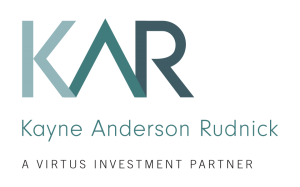
Julie Kutasov
Portfolio Manager and Senior Research Analyst
Kayne Anderson Rudnick
KAR Portfolio Manager Julie Kutasov reviews fourth quarter performance of the small- and mid-cap equity markets, top contributors and detractors in the KAR Small-Mid Cap Core strategy, and portfolio positioning going into 2024.
Listen Now
Transcript
BEN FALCONE: Hello, this is Ben Falcone, managing director with Kayne Anderson Rudnick, and with me today, I have Julie Kutasov, portfolio manager of the KAR Small-Mid Cap Core strategy.
JULIE KUTASOV: Hello, Ben, happy to be here.
BEN FALCONE: Julie, equities had strong returns for the fourth quarter characterized by a broadening out of market returns that had previously been confined to a set of mega-cap stocks for the prior nine months of the year. Can you provide our listeners with your perspective on fourth quarter performance for small and mid-cap equities and how your portfolio performed during the quarter as well as the year?
JULIE KUTASOV: Sure. It was the decline in longer-term interest rates that drove equity's strong performance during the fourth quarter. Stocks did drop in October when the 10-year U.S. Treasury yield approached 5% for the first time in 16 years, but not for long. The rally began in early November as the 10-year Treasury yield started to decline, driven by a significant improvement in the inflation outlook, and continued following the Fed's December meeting as the market interpreted Chairman Powell's comments to mean the Fed was ready to stop rate hikes and even cut and pivot from the higher-for-longer expectations just a quarter ago.
The fourth quarter's performance of the Russell 2500TM Index was driven by companies with high earnings quality, a favorable environment for us. The strategy underperformed the benchmark during the quarter, however, primarily due to our lack of exposure to the outperforming banking segment. We have a structural lower position in the banking segment due to its inherent capital intensity. Banks represent roughly 6% of the Russell 2500 benchmark and returned over 26% during the quarter as investors became more confident that short-term interest rates had peaked, and banks’ balance sheet quality had stabilized. At the same time, we benefited from our lack of exposure to the energy sector, the only benchmark sector with a negative return for the quarter. Our underweight position in the energy sector is also structural in nature due to the sector's inherent capital intensity, cyclicality, and direct commodity exposure.
For the year as a whole, performance of the Russell 2500 Index was driven by companies with stronger earnings quality and high returns on equity, but also those with high volatility, making it a more challenging environment for us. The strategy did outperform the benchmark for the year, however. We benefited from strong stock selection in the industrial and consumer discretionary sectors, as well as overweight positions in the outperforming information technology and industrial sectors and lack of exposure to the underperforming energy and utility sectors. Similar to energy, our underweight position in the utility sector is also structural in nature due to the sector's inherent capital intensity, direct commodity exposure, and in the case of regulated utilities, capital returns.
BEN FALCONE: Julie, can you discuss a few of the portfolio holdings that were key contributors and detractors to performance within the quarter and for all of 2023?
JULIE KUTASOV: Equifax was our highest stock contributor for the quarter. Other top contributors were Thor Industries, Lennox International, Fair Isaac Corporation, and Cooper Companies.
Equifax is one of the three largest U.S. credit bureaus with databases supporting billions of credit decisions annually. The company's Work Number, employment and income verification database, is a unique data asset that we believe differentiates Equifax from its competition. Shares performed strongly as investors became more positive on the short-term interest rate outlook despite challenging operating conditions with high interest rates pressuring overall lending activity.
For the year as a whole, our highest stock contributor was Lennox International. Other top contributors were Watsco, Bentley Systems, Fair Isaac Corporation, and Thor Industries.
Lennox is one of the largest manufacturers of heating, ventilation, and air conditioning (HVAC) products. The company's brand is recognized by both HVAC contractors and end customers, and scale enables Linux to leverage fixed costs, obtain purchase discounts, and benefit from nationwide marketing campaigns. Shares performed strongly following the company's reports of solid operating results with revenue growth in both residential and commercial segments, meaningful profitability expansion, and improved outlook.
LPL Financial was our weakest performer this quarter. Other detractors were Choice Hotels, Interactive Brokers Group, SiteOne Landscape Supply, and Exponent.
LPL provides independent financial advisors and financial institutions with technology, research, clearing and compliance services, and practice management programs they need to create and grow their practices. The company has been the leading independent broker-dealer for multiple decades, having established a strong reputation with both advisors and customers. LPL earns a significant portion of its profit from net interest earned on clients' operational cash balances, however, and an expectation of lower short-term interest rates negatively affected investor perception of the company's profit trajectory. We view this issue as temporary in nature and continue to believe that the company's solid market positioning remains intact.
For the year as a whole, our weakest performer was Globus Medical. Other detractors were Exponent, Jack Henry and Associates, Choice Hotels, and W.R. Berkeley.
Globus Medical is a medical device company that designs and develops implants for patients with spine disorders. Shares declined sharply in early February following the company's announcement of an upcoming acquisition of another large medical device company. While the target company did operate in Globus’s spine markets, it had a history of volatile profitability, elevated financial leverage, and high management turnover. With the transaction carrying a considerable execution risk as well as potentially becoming dilutive to Globus’s return capital, we exited our position in the company during the first quarter of 2023.
BEN FALCONE: Julie, as we head into 2024, thinking about the current backdrop for the economy as well as it being an election year, can you speak about how your portfolio is positioned relative to your benchmark?
JULIE KUTASOV: We are dealing with a great deal of uncertainty, elections outcome included, this year, particularly on the geopolitical front as it relates to growing tensions, be it those surrounding Taiwan, the Russia-Ukraine conflict, or the war in the Middle East. In fact, we are already observing recent attacks by Houthi rebels on commercial ships in the Red Sea having resulted in a steep rise in global freight trades and weeks-long shipment delays.
Importantly, inflation in the U.S. has come down meaningfully as supply chains have normalized and as labor markets have cooled. And consumer spending, the key driver of the U.S. economy, has held up well as easing inflation and strong wage growth boosted purchasing power. While improved, inflation remains elevated, however, and December CPI data released in January suggests that inflation may be more stubborn than anticipated. And while the labor market continues to soften, it remains tight with wage inflation still running above the desired level.
As the widely anticipated downturn failed to materialize, recession fears have given way to a soft-landing outlook. History tells us, however, that it does take time for interest rate increases to ripple through the economy. In the past 11 Fed rate hiking cycles, recessions typically started about two years after the central bank began raising rates. This cycle started in March 2022. While we have been impressed and quite frankly surprised by the resilience of the U.S. economy, an economic slowdown remains a key risk in our view, particularly considering continuing inflationary pressures and growing uncertainty on the geopolitical front. In addition, while contained relatively quickly and effectively, the recent banking crisis has had a tightening effect on bank lending, the lifeblood of the economy.
As always, the strategy's investment objective remains unchanged. Over an economic cycle, we strive to achieve returns that are meaningfully above those of the Russell 2500 benchmark, but with low overall risk, and we believe the portfolio is well positioned to achieve this goal. Holdings in the strategy have had return equity averaging nearly 22% over the past five years, significantly above that of the Russell 2500 Index. Importantly, unlike the benchmark, these companies achieved these ROEs with under-leveraged balance sheets. Over the past 10 years, the consistency of our companies’ earnings not only outpaced the Russell 2500 Index, but also the S&P 500. Even more importantly, capital generation, the source of future growth, also significantly exceeded the benchmark. In our experience, slowing economic growth brings investors to quality. While the outlook remains uncertain, we believe that our focus on highest quality companies is particularly relevant today.
BEN FALCONE: Julie, thanks for taking the time to provide your insight to our KayneCast listeners.
JULIE KUTASOV: Thanks, Ben.
This information is being provided by Kayne Anderson Rudnick Investment Management, LLC (“KAR”) for illustrative purposes only. Information contained in this material is not intended by KAR to be interpreted as investment advice, a recommendation or solicitation to purchase securities, or a recommendation for a particular course of action and has not been updated since the date of the material, and KAR does not undertake to update the information presented should it change. This information is based on KAR’s opinions at the time of the recording of this material and are subject to change based on market activity. There is no guarantee that any forecasts made will come to pass. KAR makes no warranty as to the accuracy or reliability of the information contained herein.
Past performance is no guarantee of future results.
3185262
